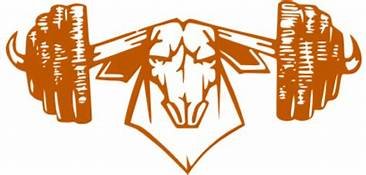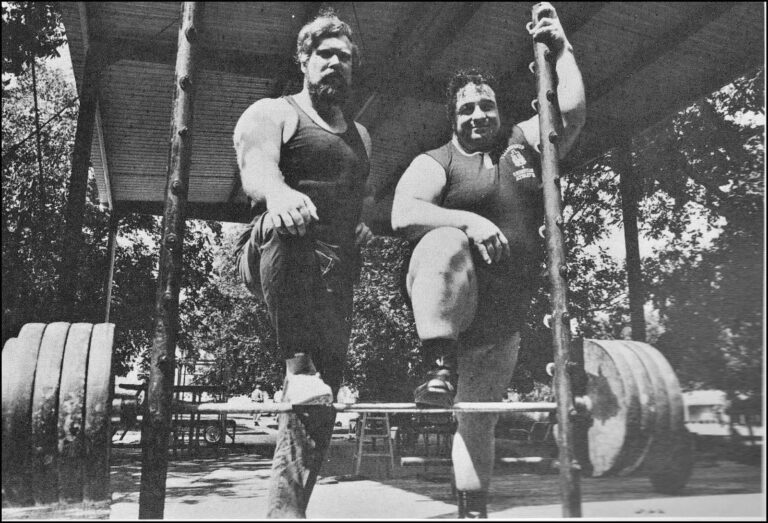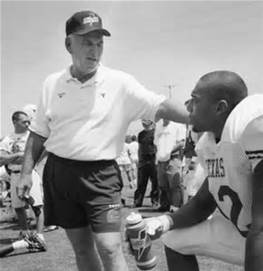Roy McLean a Precursor to contemporary Longhorn strength coaches
Roy McClean, Lutcher Stark, and Theo Bellmont were convinced that weightlifting could enhance an athletes’ skills.
1919 – 1967 ROY MCCLEAN SLOWLY AND METHODICALLY PROVES THAT ATHLETES WHO LIFT WEIGHTS ADD STRENGTH, QUICKNESS, AND SPEED.
Roy J. McLean, born in Austin in 1897, grew up on the edge of the campus and was a “mascot” for the UT football and baseball teams from 1906-1911. McLean entered the University of Texas in the fall of 1913 at age 16. In his first semester in the afternoons, he had only one class, Physical Training. That class met at the University YMCA building on Guadalupe, where Mclean began spending most of his free time and met the newly-named athletic director L. Theo Bellmont.
Roy McLean
One of Bellmont’s first hires was a freshman—Roy J. McLean—who was a whiz at shorthand. Beginning in 1914, McLean served Bellmont as a recording secretary, and he often watched the workouts of Stark and Bellmont, who would train with weights during Stark’s frequent visits to the campus. Before long the two slightly older men included young McLean in their training sessions. McLean became a convert to the barbells, too, and in 1919, after “Mac’s” graduation, Bellmont hired him as an instructor and coach.
That same year McLean taught the first organized heavy weight-training classes ever taught in the U.S., and in the 1920s he also began to serve The University as coach of both the cross country and wrestling teams. Because of what he’d learned from Stark and Bellmont, McLean also broke new ground by requiring his athletes to train with weights. For thirteen years straight, his teams won the Southwest Conference in cross country, and he also produced several national champions and Olympians in wrestling. During his fifty years at UT, and with the full support of Stark and Bellmont, McLean also built the largest and most well-equipped weight training facility on any campus in the United States.
In March of 1914, was hired by Bellmont and set up the first accounting system for the Athletic Department. Roy McClean managed the ticket sales for the home football games.
Later that same month, Bellmont introduced McLean to H.J. Lutcher Stark, who’d been the manager of the 1910 football team and would later serve for 24 years on the Board of Regents. (For more on Lutcher Stark, click here). Lutcher told Bellmont about his trip to Philadelphia learning how to lift weights and eat properly from Alan Calvert, owner of the Milo Barbell Company and the publisher of Strength magazine. McLean said, “Lutcher had dropped by for a visit and to work out with his barbells which he always carried in his car, and which he said had changed him from a 220-pound fat boy into a 180-pound muscular athlete.” At that moment McLean was hooked understanding that sets and repetitions built muscle. Following that visit, McLean and Bellmont continued training and Mclean eventually added thirty pounds of muscle to his lanky frame and became a true believer in the benefits of weight training.
McLean uses the techniques suggested in the Milo weight training program to add thirty pounds of muscle to his thin frame, and Lutcher Stark uses barbells to drop his weight from 220 pounds of fat to 180 pounds of muscle.
With two Milo barbells and some dumbbells, in 1919, McLean starts the first class in weight training. His focus breaks all the traditional rules of practice. Most coaches still believed that lifting weight made athletes muscle-bound, but they were proven wrong. The eleven male students in McLean’s class had more muscle mass and could jump higher and run faster than before. The popularity of weight training arrives at UT, leading to more classes and more Milo barbells. By 1929 demand for weightlifting classes are so high that a weight room was added to Gregory Gym. When McLean retired in 1967, the men’s physical training program had 660 plus students enrolled in 22 classes.
This is a photo of the 1922 varsity University of Texas wrestling team. Roy McLean is in the top row, far right.
After the war ended, McLean returned to UT to work on a Master’s Degree and was offered a teaching and coaching position by Bellmont, in 1920 even though he would not finish his degree until 1923. As coach of the wrestling and the cross-country teams he incorporated weight training and other conditioning techniques.
Ralph Hammond
Mclean was a great success as a coach. He helped wrestling star Ralph Hammond earn a spot on the 1928 Olympic team and his Longhorns won many conference championships. In cross country, Mclean remained head coach until 1933 when it was decided that Clyde Littlefield would step down as head football coach and take over all track and field teams.
ROY McLEAN IS LOWER ROW IN THE MIDDLE. HE WAS ALSO THE CROSS COUNTRY COACH
Beginning in the late 1950s, Roy McLean encouraged a UT letterman in tennis to become a competitive weightlifter. That young student, then an undergraduate, really took to the weights and—when he began work on a Master’s degree—McLean hired him as a Graduate Teaching Assistant. “Mac” also shared with his protégé a large library in the field of sports and physical culture and instilled in that young man a deep fascination with everything related to weight training. In time, that fascination inspired the graduate student to win lifting championships in both weightlifting and powerlifting, to write extensively about weight training and its history, and to begin collecting books and magazines in the field. Terry Todd was that student.
1960’s -Roy McLean is the far left of the top row, while Terry Todd is third from the right, top row. This photo is part of an article that Roy McLean authored in Strength and Health that gives a brief glimpse into the early days of strength training at the University of Texas in the 1960s.
By this time, however, Mclean had found his true calling in the weight room. In 1919 when he began teaching at UT, Mclean requested permission to schedule a class in weight training. The two Milo barbells and several pairs of 10- and 15-pound dumbbells owned my Mclean and Bellmont comprised the equipment for that first class, and the training sessions were held in the wrestling room, in one of the abandoned military barracks on campus. In that first class, McLean had 11 freshmen and none of them had ever seen a barbell before. The other coaches, according to Mclean, forbade their athletes to even touch a weight—and told them it would make them muscle-bound. The eleven male students, however, loved the class, and after McLean tested them at the end of the semester and showed them that they could jump higher, run faster, and had more muscle on their bodies, they spread the word to other students and there were soon more young men wanting to take his weight training class than he could handle. And so, additional courses were added, and more Milo barbells were shipped down from Philadelphia.
By 1929 when Gregory Gym was built to house the men’s Physical Training Program, demand was so great that a special weight room was added to the new building to accommodate what had then grown to ten classes per semester. Over the next five decades, interest in weight training continued to grow and in 1967, when Mclean finally retired as an Associate Professor, the men’s physical training program was offering 22 sections of weight training each semester. With 25-30 students approximately in each section, this means that over the course of his long and profitable life, Roy J. McLean taught tens of thousands of Longhorn men how to lift weights.
Click here to view the extended file
When Jan and Terry Todd I brought our collection to UT in 1983, Roy McLean endowed the Roy J. McLean Fellowship in Sports History to help make a home for the collection on campus. Thus it was that the lessons learned by Lutcher Stark from Alan Calvert in Philadelphia in 1913 influenced the hiring of UT’s first Athletic Director; the hiring of Roy McLean, the man who taught the first modern weight-training classes in the U.S.; the first use of weight training to enhance athletic performance at UT; and our decision to make a final home for our burgeoning collection at The University of Texas.
Most UT coaches up until 1973 chose not to have their athlete’s weight lifting. It was considered detrimental and dangerous to the athletes. After OU decimated the Horns in 1973, the Longhorns asked why, and Jay Arnold answered the question. “We were part of the ‘old school’ when it came to physical and strength training.” “We would lift and condition in the spring and off-season but put the weights away during the season. Oklahoma chose weight lifting all year long. We changed after that game and never looked back. We were in an era of enlightened transition as far as that was concerned.”










